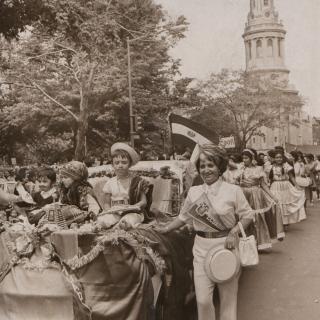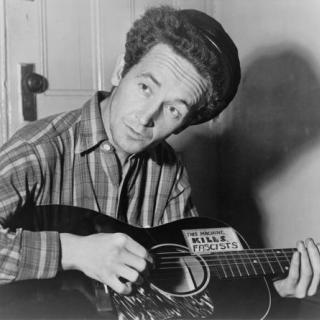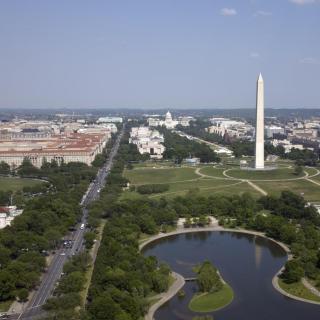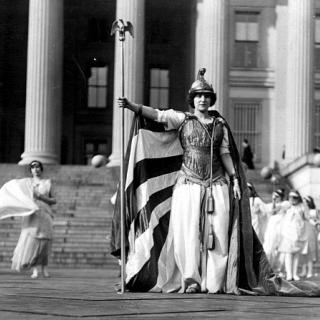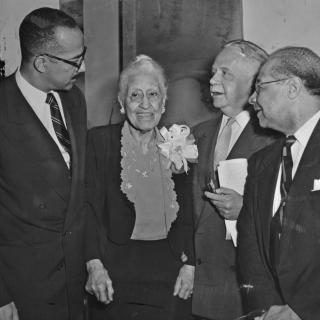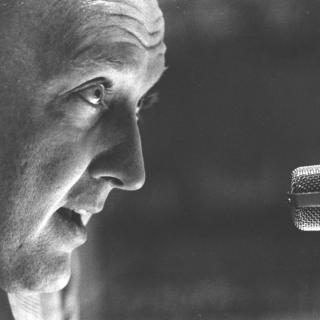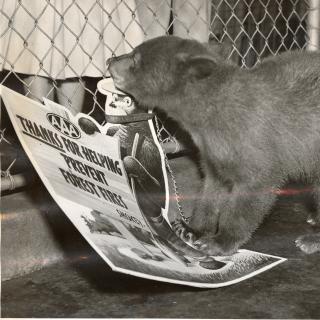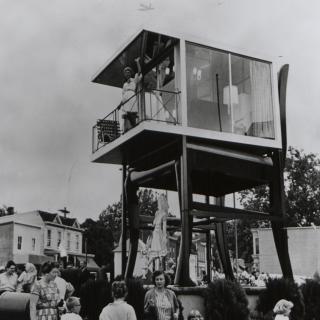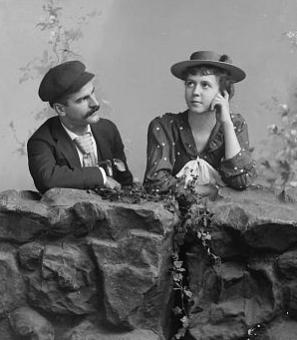How to Exhibit the Enola Gay Was a Decades-Long Struggle for the Smithsonian
In the summer of 1995, the National Air and Space Museum made headlines by unveiling its newest exhibit: a seemingly unremarkable B-29 bomber attended by only a small text panel and a looping video of its restoration. At a glance, it was little different from dozens of other similarly staged artefacts at NASM. Nothing about the understated display seemed to warrant newspaper coverage.
This particular plane, however, was the Enola Gay. As its text panel succinctly explained, it had dropped the atomic bomb on Hiroshima on August 6, 1945, killing 135,000 people.1 The no-frills display and handful of paragraphs were the anticlimactic result of an epic struggle which had spanned five years and cost NASM nearly two million dollars, a total PR meltdown, and the director of the museum his job.
Even fifty years on, the Enola Gay’s legacy was unsettled. It was to some an icon of American ingenuity and triumph. To others, it was a manifestation of hubris and hate. The plane itself was a bombshell, one NASM assumed it could handle in an exhibition. Unfortunately, the bombshell exploded not in the careful curation of a museum, but in the public square, the press, and Congress. There, NASM was unable to defuse anything.
The Smithsonian had been sitting on an eventual Enola Gay exhibit for decades. Sitting unsupervised for years in a remote field at Andrews Air Force Base, the plane deteriorated as the elements, animals, and souvenir hunters had chipped away at it. Throughout the 1980s, veterans lobbied hard for its restoration and display. The Smithsonian concurred, and restoration work began in Suitland, Maryland. Staff hoped to have it ready to display by the 50th anniversary of the war.
Responsibility to craft an exhibit fell in 1991 to recently appointed NASM director Martin Harwit. The first academic in the role, Harwit aimed to transform NASM from “the central shrine of the military-industrial complex” to a critical, scholarly institution “exploring the social contexts and human implications” of technology.2, 3 This, along with the approaching 50-year anniversary, would have important ramifications for how NASM planned to represent the Enola Gay.
From the start, NASM knew any attempt to display the Enola Gay would be contentious. Protesters regularly threw red liquids on the museum’s rockets around the anniversary of the atomic bombings.4 But current signs were positive: Harwit had curated a well-received exhibit reexamining the V-2 rocket, and a video of atomic bomb damage in Japan premiered to “no negative commentary whatsoever.”5 The Enola Gay offered a golden opportunity to critically reexamine America’s decision to drop the bomb, and the fallout—both short and long-term—that followed.
Before writing the exhibition script, NASM conducted a sixteen-month program of “lectures, films, panel discussions, and scholarly symposia on strategic bombing” and nuclear warfare.6 Contributors disagreed, sometimes acutely, on the rationale, effects, and judgements of the bombing. One member of NASM’s Research Advisory Committee, Noel Gayler, resisted even showing the plane. Any display, he argued, “could be interpreted as a celebration of destruction.”7 The rest of the committee ruled to proceed: the plane’s educational potential outweighed Gayler’s concerns.
Those discussions produced an intensively-researched 500-page exhibition script called “Crossroads: The End of World War II, the Atomic Bomb, and the Origins of the Cold War.” With it, the museum took a bold tack: not only investigating historical facts of the bombing, but probing its necessity and justifications, and its impacts on our future. Per a planning document, the “character” of the bombing was “debatable.”8 Harwit envisioned that “Crossroads” would provide “not an opinion piece but rather the basic information that visitors will need to draw their own conclusions.”9
The initial script, while not fault-free, was a balanced, cautious account of history. Advisory scholars praised the “careful and professional” script which would “inform, challenge, and commemorate” the history surrounding the Enola Gay.10 Visitors would proceed through five sections: the Pacific war in 1945, the decision to drop the bomb, the aviators and scientists who made the Enola Gay flight possible, the aftermath at Ground Zero, and the bombing’s role in triggering the Cold War. The full exhibit would take up 5,500 feet and the (mostly) restored Enola Gay would sit center stage, the crown jewel of the collection.
For confidential comment, NASM forwarded their script to the Air Force Association. Comprised of active and retired servicemembers, the AFA already mistrusted the new direction NASM had taken under Harwit. They perceived a new “disparaging attitude” towards military aviation and resented the lack of wider Air Force recognition in Washington.11 Especially because “Crossroads” debuted on the 50th anniversary of the war, any exhibition of the Enola Gay was by extension a judgement on servicemen. The “Crossroads” script read like a betrayal. Despite receiving the script confidentially, John Correll, editor-in-chief of Air Force Magazine, wrote a sharp public criticism of the exhibit. He attacked its “politically correct curating,” sympathetic tone towards the Japanese, and the graphic imagery of the exhibit—which favored, he charged, only Japanese suffering.12
To some extent, Correll had a point. While the research was nuanced and balanced, the emotional structure of “Crossroads” was not. Its tone and mood could be construed as “moralizing,” questioning “American motives, honor, decency, and moral integrity.”13 A 1993 planning document made this explicit: transitioning from the section about American innovation to one about Ground Zero, “[visitors] will be immediately hit by a drastic change of mood and perspective… The aim will be to put visitors on the ground during the atomic bombings,” including life-size photos of victims and melted artefacts.14
Correll warned NASM: “You’re basically slapping a lot of veterans in the face.”15
NASM had just run into an uncomfortable reality: many Americans, especially veterans, were unprepared to critically examine the bombings. A curator asked Harwit, “Do you want to do an exhibition intended to make veterans feel good, or… that will lead our visitors to think about the consequences of the atomic bombing of Japan? Frankly, I don’t think we can do both.”16 Nonetheless, Harwit was determined to try. While curators were willing to work with the AFA—even rewriting the exhibit with a new title, “The Last Act”—the inquisitory heart of “Crossroads” remained.
The AFA did not like the implications of those questions. It kicked “into high gear,” circulating the offenses it considered most egregious.17 Its publications attracted the media and other veterans groups to weigh in. The Washington Post called the exhibit “an anti-nuke morality play in which Americans were portrayed as ruthless racists hell-bent on revenge for Pearl Harbor, with the Japanese as innocent, even noble victims.”18
Sentences from the script, often ripped from context, grew infamous. Oft-quoted was a description of kamikaze pilots as “youths, their bodies overflowing with life.”19 This was not a curator’s characterization but a direct quote from a Japanese pilot. Many journalists never read the 500-page script, which was not widely available.
NASM struggled to respond to the sudden deluge of complaints about its “liberal, revisionist interpretation” of history.20 Spurred by media furor, Smithsonian magazine subscribers had sent 20,000 letters, the vast majority complaining. According to a curator, “95% were essentially calling for blood.”21
Harwit made public pleas for patience and understanding. In a Washington Post editorial, he emphasized the dissonance of themes surrounding the Enola Gay. For the veterans’ generation, the plane was a symbol of innovation, bravery, and sacrifice. For their children, its bomb ignited the threat of nuclear war and continuous diplomatic crises. NASM had to balance these “conflicting views” to ““deliver an accurate portrayal that conveys the reality of atomic war and its consequences.”22
By autumn, 1994, the Enola Gay had become a national issue. Subsequent drafts and relevant stakeholders on the exhibition snowballed: AFA, then the American Legion, then the military. Although some veterans supported the scripts, most wielded their vetoes liberally. Some of the changes demanded were, according to a museum professional, “unwarranted, some outrageously so.”23 The AFA categorically rejected any exhibit that questioned American morality, portrayed Americans as motivated by racism, or the Japanese as victims.
Some critiques improved the exhibit. NASM added a preface contextualizing Japanese aggression and the Pacific theater before 1945, which had been lacking in the original script. This addition doubled the exhibition floor space. The balance between Japanese and American casualties also grew more equal.
Others were not so helpful. Negotiations ground to a stalemate over projected casualties of an invasion of Japan—a key point of the bomb’s justification. NASM initially quoted a figure of 10,000 as opposed to the 30-50,000 suggested by a researcher. Both numbers were lower than the traditional figure of half a million. Critics accused curators of purposefully “prun[ing] the figure to render the bomb-drop immoral.” 24 NASM never challenged the assumption that saving American lives justified the bombings, but no one could agree on how many lives might have been saved.
NASM also scaled back its Ground Zero display. The most graphic photos and Japanese artefacts were removed from the floor. Curator Tom Crouch regretted the change. Telling the story “from 30,000 feet” wasn’t “an honest telling,” he said. “You have to have the stuff on the ground, too.”25 He was not alone: historians and writers complained to Secretary Adams that the new exhibit was so littered with changes it was now “mere propaganda.”26
Some veterans opposed NASM interrogating the Enola Gay’s context at all. They wanted the plane to speak for itself and favored the staging of the Bockscar, which bombed Nagasaki, at the Air Force Museum. That exhibit had “little historical context… or analysis.”27 Among these proponents was Paul Tibbetts, the pilot on the Hiroshima mission. He considered his plane a “peacekeeper” and NASM was displaying it as “a package of insults.”28 Other veterans took Tibbetts’ phrasing up as a slogan.
Harwit was emphatically against the idea. The Enola Gay was one of hundreds of B-29s. Only context gave the craft its significance; displaying the plane without it defeated the point. “There’s only one reason why that airplane is [here],” he said, “and that is because it dropped the bomb on Hiroshima.”29
Finally, the furor around the exhibit attracted the interest of Congress. The Enola Gay issue exploded after Republicans won an unexpected victory in the 1994 congressional elections. Many had campaigned on burgeoning culture war issues, and “Crossroads” made a perfect target: a countercultural attack on American character, coming right from Washington’s heart. To Newt Gingrich, the public uproar was “the reassertion by most Americans that they’re sick and tired of being told by some cultural elite that they ought to be ashamed of their country.”30
One Kansas senator wrote to Secretary Adams, offering to display the Enola Gay “with understanding and pride” in her state’s museums. Harwit attended a meeting with legislators in August 1994, which spiraled into hostility. One accused him of making kamikaze pilots “heroic” and disregarding American heroism. According to Harwit, the lawmakers implied that NASM had “no business getting involved in important historical matters;” that was for the Museum of American History.31 All the while, the tide of public outcry grew louder and more hysterical.
By January 1995, 81 legislators had petitioned for Harwit’s removal and Congress seemed prepared to humor the American Legion’s demands for hearings on the Smithsonian’s management. At this point, the script had cost $296,000 to develop, and projected staging costs climbed to $600,000, not including the $1 million already spent restoring the Enola Gay.32
All these considerations fell on the Smithsonian’s new Secretary: I. Michael Heyman. Once likening the Smithsonian to a university and defending its independence from “political direction,” he had now backtracked. Like Tibbetts, Heyman assigned the Enola Gay to a category including artefacts like the Star Spangled Banner, which could “speak for themselves.”33 He would be more flexible about the plane’s display.
Another factor influenced Heyman: 72% of the Institution’s budget was federally apportioned, and Congress seemed willing to hold it hostage if Heyman did not conform. One Representative told him outright: “I can tell you, you will not get [funding] from this Congress if we have controversies like this.”34
With academics complaining on one side, veterans on the other, and Congress looming over his head, Heyman weighed his options. Canceling the exhibit jeopardized the Smithsonian’s scholarly integrity. Pushing forward amounted to declaring war on Congress. As a Smithsonian chairman said, the debacle was “the kind of nightmare that Washington hands out to people who come here to do important jobs.”35 To protect the Smithsonian’s funding and future, Heyman, who had once strongly defended the Smithsonian’s autonomy, announced NASM would scrap the entire Enola Gay script.
“We made a basic error in attempting to couple an historical treatment of the use of atomic weapons with the 50th anniversary commemoration,” he said. “Veterans and their families… were not looking for analysis.” As for the scholars who lamented the decision, Heyman asked where they had been as the Smithsonian was drowning under public outcry. Had they defended NASM then? They would just have to “get over it.”36
Instead, the Enola Gay debuted in a muted anticlimax. After months of tug-of-war between staff, scholars, and interest groups, the final exhibit consisted only of the mostly-restored plane, a handful of headlines from August 1945, and a video of the plane’s crew and restoration. Pared down and stripped of historical inquiry, it was a far cry from Harwit's initial 5,500-square-foot vision.
At the display’s opening, a reporter asked why it “failed” to mention the “destruction and devastation at Hiroshima."
Heyman responded: “I… decided to leave it more to the imagination.”37
Some praised the decision. Rep. Peter Blute, who spearheaded the Congressional petition for Harwit’s removal, said Heyman was “sound” in cancelling a “politically correct diatribe.” Others did not agree. The Organization of American Historians criticized the exhibit for being “patriotically correct” while the Baltimore Sun called the final display, “Enola Lite, 97 percent controversy-free.”38 The Retired Officers Association “sincerely deplored” the cancellation.39
The anti-nuclear group Physicists for Social Responsibility called the Enola Gay disputes “an American debate over who will interpret our history.” For now, they said, “a group of veterans and conservative congressmen has won that battle.” It was an apt prediction: Heyman’s decision “discouraged innovative and challenging history exhibits” for years.40
Harwit resisted cancellation to the end, warning it would damage the morale of staff who had worked on it tirelessly for years. Besides the bad optics of “buckling to political pressure,” NASM would lose the educational opportunities of an “excellent” exhibit.41 In part because of the Enola Gay and in part because of conflicts with Heyman’s leadership, Harwit resigned from NASM in May 1995.
The long awaited -- and long debated -- Enola Gay exhibit opened at the National Museum of Air and Space the following month. The Washington Post summed it up succinctly: “The original exhibit would have explored the long-contentious question of whether the bomb was needed to end the war. The finished exhibit skips the issue.”42 Of course, that didn't mean the opening was free of controversy. During previews, someone splashed red paint over the plane. In July, a group of protesters handed out pamphlets and began shouting “We repent. We regret.” Others poured human blood and ashes over the fuselage.43
After three years, the scaled back Enola Gay exhibit closed. The plane was removed in 1998 for full restoration and now sits in a sparse display at NASM’s Udvar-Hazy Center in Virginia.
Footnotes
- 1
BBC. “Fact File : Hiroshima and Nagasaki.” British Broadcasting Corporation, 2005. https://www.bbc.co.uk/history/ww2peopleswar/timeline/factfiles/nonflash/a6652262.shtml.
- 2
Wallace, Mike. “The Battle of the Enola Gay.” Museum News, July/August 1995, 1995.
- 3
Kohn, Richard H. "History at Risk: The Case of the Enola Gay." History Wars: The Enola Gay and Other Battles for the American Past. Ed. Edward Linenthal and Tom Engelhardt. New York: Metropolitan, 1996. 140-70.
- 4
Dubin, Steven C. Displays of Power: Memory and Amnesia in the American Museum. NYU Press, 1999. https://archive.org/details/displaysofpowerm0000dubi/page/188/mode/1up?q=%22enola+gay%22
- 5
Wallace, Mike. “The Battle of the Enola Gay.” Museum News, July/August 1995, 1995
- 6
Kohn, Richard H. "History at Risk: The Case of the Enola Gay." History Wars: The Enola Gay and Other Battles for the American Past. Ed. Edward Linenthal and Tom Engelhardt. New York: Metropolitan, 1996. 140-70.
- 7
Kohn, Richard.
- 8
Kohn, Richard.
- 9
Harwit, Martin. “THE ENOLA GAY: A NATION’S, AND A MUSEUM’S, DILEMMA.” The Washington Post, August 7, 1994. https://www.washingtonpost.com/archive/opinions/1994/08/07/the-enola-gay-a-nations-and-a-museums-dilemma/e6354e7f-e190-4f0e-816b-6969edd6213d/.
- 10
Kohn, Richard.
- 11
Kohn, Richard.
- 12
Correll, John. “The Smithsonian and the Enola Gay.” Air Force Association, March 15, 1994. https://web.archive.org/web/20120503124152/http:/www.afa.org/media/enolagay/03-001.html.
- 13
Kohn, Richard.
- 14
Kohn, Richard.
- 15
Dubin, Steven.
- 16
Kohn, Richard.
- 17
Harwit, Martin. An Exhibit Denied: Lobbying the History of Enola Gay. Springer Science & Business Media, 2012. https://archive.org/details/exhibitdeniedlob0000harw/page/312/mode/2up.
- 18
Wallace, Mike.
- 19
Dubin, Steven.
- 20
Michael Kilian. 1995. Smithsonian puts enola gay display on hold: Japan as 'victim' outrages vets. Chicago Tribune (1963-1996), Jan 21, 1995.
- 21
Dubin, Steven.
- 22
- 23
Wallace, Mike. “The Battle of the Enola Gay.” Museum News, July/August 1995, 1995.
- 24
Wallace, Mike.
- 25
Dubin, Steven.
- 26
Kohn, Richard.
- 27
- 28
Dubin, Steven.
- 29
Dubin, Steven.
- 30
Kohn, Richard.
- 31
Harwit, Martin. An Exhibit Denied: Lobbying the History of Enola Gay. Springer Science & Business Media, 2012. https://archive.org/details/exhibitdeniedlob0000harw/page/312/mode/2up.
- 32
Hirsch, Arthur. “Smithsonian Cancels Exhibit on Atomic Bomb.” Baltimore Sun, January 31, 1995. https://www.baltimoresun.com/news/bs-xpm-1995-01-31-1995031159-story.html.
- 33
Kohn, Richard.
- 34
Kohn, Richard.
- 35
Kohn, Richard.
- 36
Kohn, Richard.
- 37
Harwit, Martin. An Exhibit Denied: Lobbying the History of Enola Gay. Springer Science & Business Media, 2012. https://archive.org/details/exhibitdeniedlob0000harw/page/312/mode/2up.
- 38
Dubin, Steven.
- 39
Kohn, Richard.
- 40
Dubin, Steven.
- 41
Kohn, Richard.
- 42
Achenbach, Joel, "Enola Gay Exhibit: Plane and Simple; Air and Space Museum Focuses on the Hardware, Skirts the Horror, The Washington Post, June 28, 1995: A1.
- 43
3 arrested at messy enola gay protest smithsonian exhibit continues to draw controversy: [SECOND edition]. 1995. San Francisco Examiner, Jul 03, 1995.


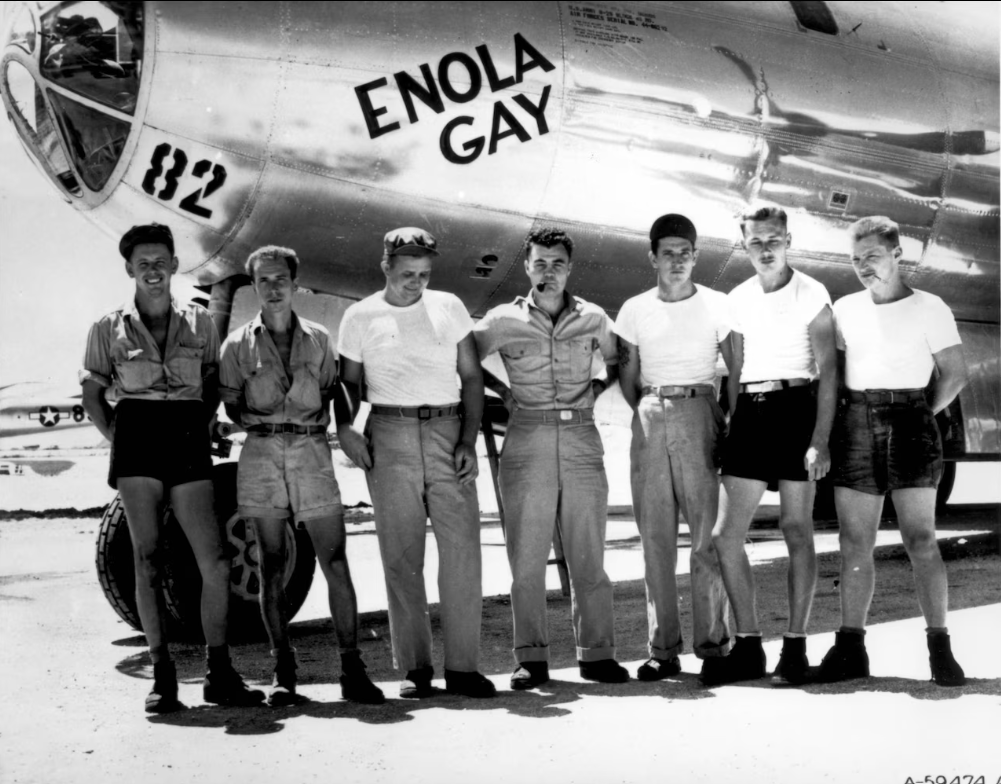
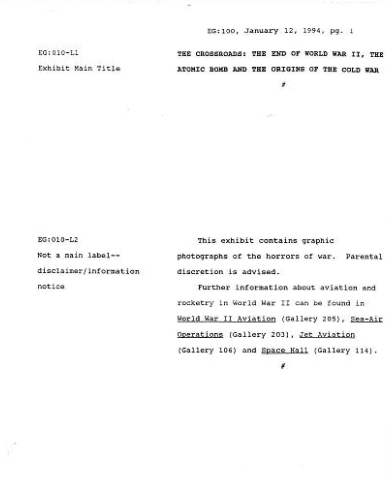

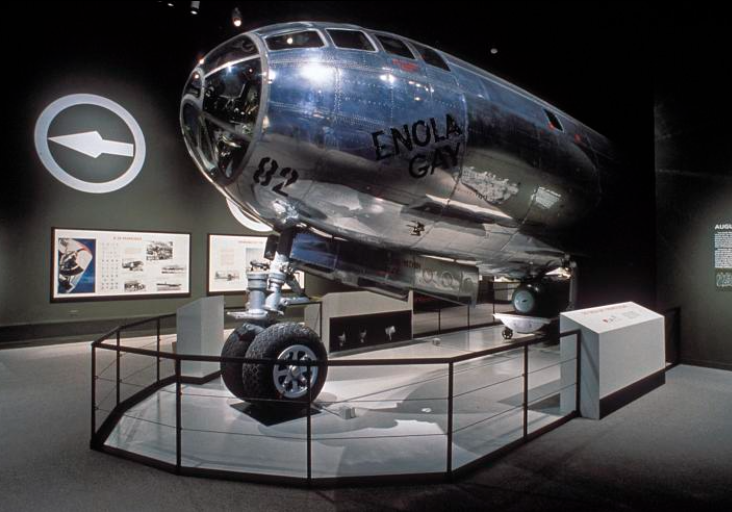
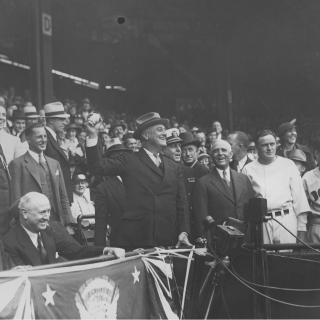
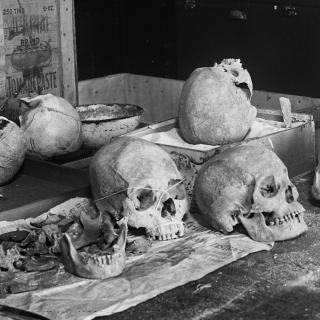
![Sketch of the mythical fuan by Pearson Scott Foresman. [Source: Wikipedia]](/sites/default/files/styles/crop_320x320/public/2023-10/Goatman_Wikipedia_Faun_2_%28PSF%29.png?h=64a074ff&itok=C9Qh-PE1)
